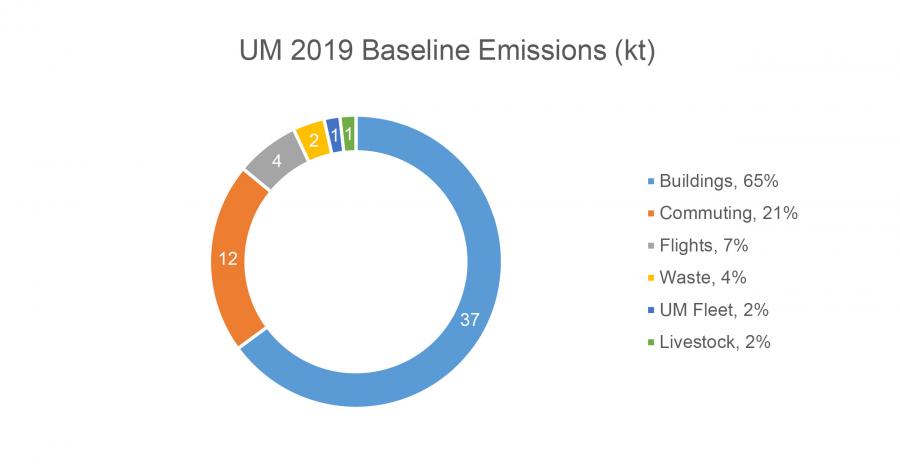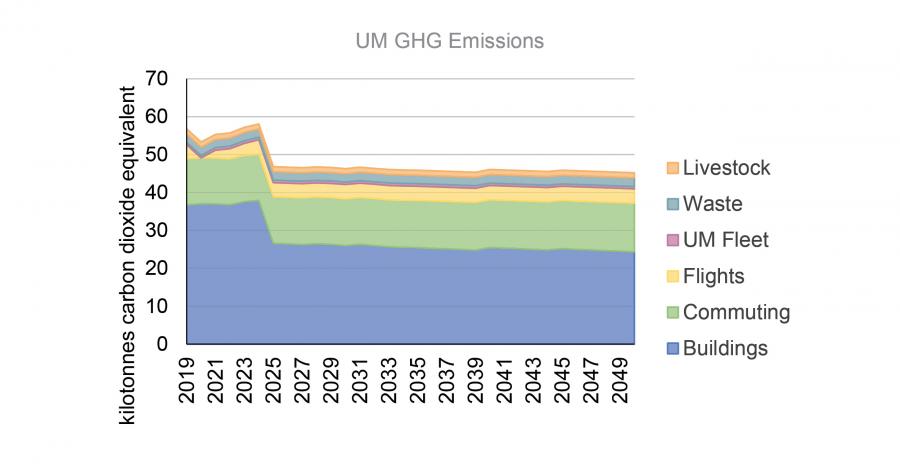Mobilizing more resources for action-oriented climate change research and skills creation
Climate
UM is committed to drastically reducing our carbon emissions by 2050. As a global leader in Arctic sea-ice and climate change research, we strive to make sustainable choices, find research-based solutions and take immediate and practical actions to reduce our impact today and in the future.
Global Universities and Colleges Climate Letter
In 2020, UM signed the Global Universities and Colleges Climate Letter, which declares the need to take immediate action for climate change. The letter commits UM to the following:
-
-
Pledge to reach net-zero by 2030 or 2050 at the very latest
-
Increasing the delivery of environmental and sustainability education across curriculum, campus and community outreach programmes
Climate Action Plan
Within the UM Sustainability Strategy 2019-2023, the first step in addressing UM’s climate impacts is the creation of a Climate Action Plan to fulfill the commitments of 50 per cent emissions reduction by 2030 and net-zero emissions by 2050.
Ways to participate
Online sessions
We heard you!
Earlier this year, UM students, staff and faculty were invited to participate or hold their own small group discussions with fellow members or classmates. Thank you to all that participated. A document sharing what we heard will be available shortly.
Survey
Thank you for participating!
A survey was created to gather feedback on potential action selection for the Climate Action Plan. The questions were organized around low-carbon “big move” areas, including: renewable energy generation, transportation, building retrofits, and waste. Responses were collected, analyzed, and used to help shape the low-carbon pathway toward net-zero by 2050. The survey is now closed.
Engagement Strategy
Intent
The Engagement Strategy is the framework that will ensure key internal and external stakeholders are given opportunities to provide feedback that is used to create the best climate action plan possible, and to establish a community that will support the implementation of the plan through to its completion.
FAQs
What are our baseline emissions?
One tonne of GHG emissions looks like a two-storey high sphere. Our energy use, waste, and livestock produce 57,000 tonnes of greenhouse gas emissions every year – 57,000 spheres!
The following graph highlights our emissions from 2019.
What are our projected emissions to 2050 based on current plans?
Energy and emissions modelling is helping UM establish the scale of our emissions reduction challenge. We have taken stock of current campus energy use and emissions and modelled what energy use and emissions production will likely be over the next 30 years.
Emissions are expected to decrease, mostly due to plans to partially switch natural gas heating in our Fort Garry campus district energy system to electricity. Since Manitoba’s grid electricity is produced almost entirely by hydro electric dams, our emissions will drop when we switch. Buildings are responsible for the majority of our emissions, but transportation and flights also contribute significantly. Our waste and livestock also produce emissions.
The following graph highlights our projected emissions based on current plans.
What are we doing with respect to energy?
The University of Manitoba has been actively managing and minimizing its “stationary energy” (mostly energy used in buildings) use for years. As a result, its “energy use intensity” (the amount of energy used per square metre) in buildings has decreased by 32% since implementing energy efficiency measures over the past 30 years.
These energy efficiency measures include things like:
- Replacing or upgrading windows and doors as they begin to leak;
- Regularly recalibrating (resetting so it measures correctly) older heating, ventilation and air conditioning (HVAC) systems to ensure monitors and control functions are operating correctly;
- Cleaning ducts and coils;
- Replacing incandescent lighting with LED lighting; and
- Adding insulation.
Committing to a goal of emitting zero greenhouse gases by 2050 means the UM needs to be more energy-efficient, using energy wisely and wasting none. As part of developing the Climate Action Plan, the University is considering two approaches to reducing stationary energy use:
- Continue improving the energy efficiency of buildings with higher energy efficiency standards for new buildings, and major upgrades for existing buildings.
- Change our energy sources to those that don’t emit greenhouse gases. This could involve switching from traditional (i.e. fossil fuel) natural gas to renewable natural gas, hydrogen, or electricity (which is virtually emissions-free in Manitoba) for heat. It may also be possible to improve the stability and resilience of the University’s electricity service by installing wind electricity generation systems and ground, roof, and even window solar electricity generation on our campuses. If these systems were accompanied by energy storage systems, this would further bolster our resilience to power outages.
What are we doing to reduce our greenhouse gas emissions?
Ongoing energy efficiency measures help reduce costs and greenhouse gas emissions. However, we must reduce our emissions more and faster than we’ve done in the past if we are to meet our climate change targets. As a result, we are assessing what efforts are needed.
Glossary
Greenhouse Gas Emissions (GHGs)
Gases that trap heat in the atmosphere. The two main emitters are Carbon Dioxide (CO2) produced mainly through the burning of fossil fuels, and Methane (CH4) produced most commonly from the production of fossil fuels and the anaerobic decomposition of organic waste.
Energy efficiency
Refers to the degree to which energy using activities can avoid wasting energy.
Stationary energy
Refers to energy used for purposes other than transportation. On the University campuses, stationary energy consists primarily of fuel used to warm or cool buildings and to operate lights and equipment within buildings. The two types of fuel we use for this purpose are natural gas for heat, and electricity for cooling, lights, and equipment.
Energy Use Intensity (EUI)
We measure how efficiently we’re using our stationary energy using a metric called “Energy Use Intensity”, or an indication of the amount of energy used per square metre of building space. We can add up all of the different types and sources of energy used in a facility and translate it into this one expression of the total amount of energy used per unit of area for that building. We can then compare that to other buildings, and to standards for different types of facilities, to benchmark our energy use and monitor the effectiveness of our improvements.






